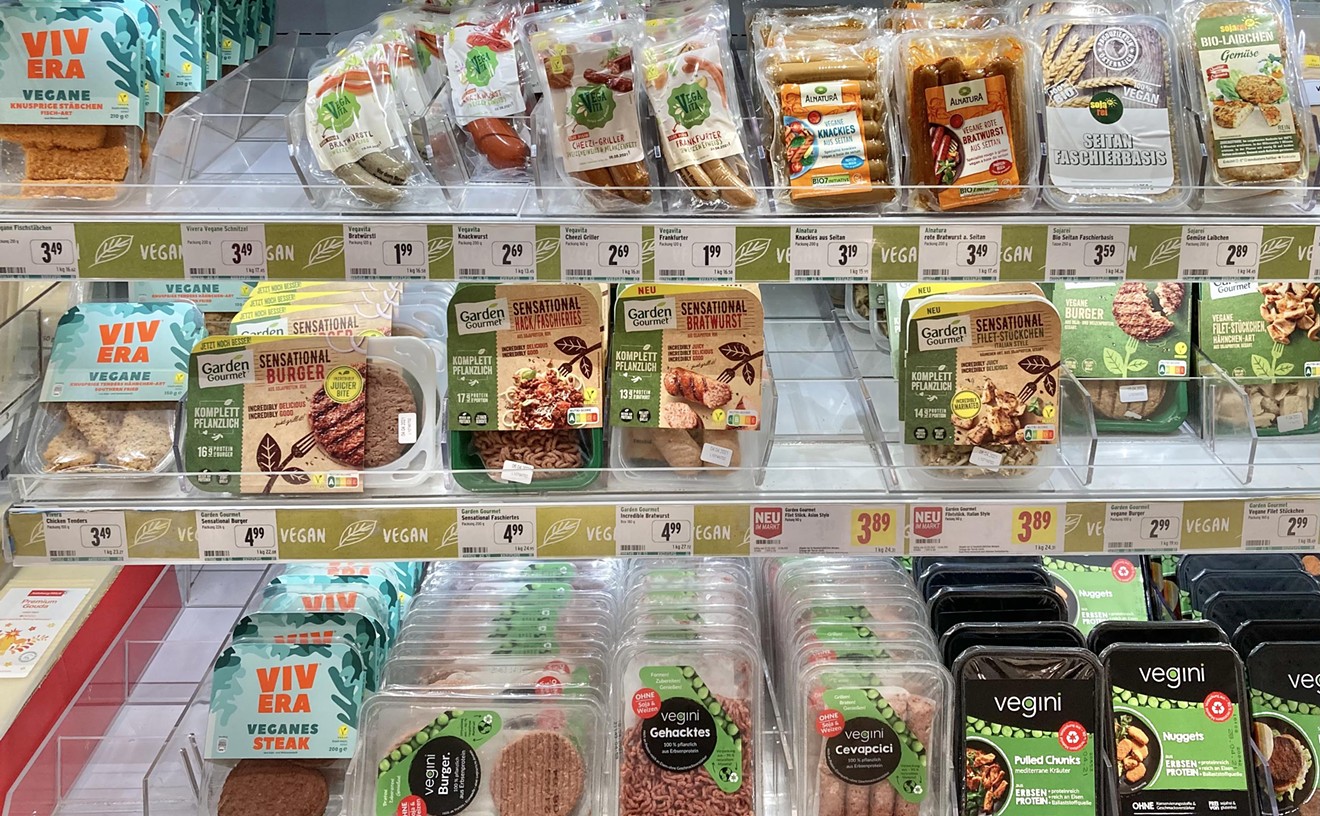It takes a couple of trips to find the chirpers available, and to be honest, there are a lot of dishes I'd work harder for. The bugs, roasted with garlic, lemon and lots of salt, taste like crisp bits of bark. So why bother? I guess it helps to know that ounce for ounce, dried insects have triple the protein of mammals and birds, and a much higher vitamin and mineral content. And that they're popular in Oaxaca, Mexico, partly because it takes 10 times as much food, space and time to raise a pound of beef as it does to raise a pound of bugs. Indeed, scientists say that entomophagists (bug eaters) could satisfy all their nutritional needs on a farm the size of a kitchen cupboard.
Such creativity, and frugality of space, helps explain the wonderland that is Restaurant Oaxaca, also known as Mini Mercado Oaxaca (pronounced wä-HÄ kä). The place is tiny, but packed to the rafters with Mexican gifts (check out the bobblehead farm animals and hot-pink pig piñata), candy, clothing (spaceship underwear!), groceries and lots and lots of food. The market makes the decor, the walls hung here and there with posters and maps of the homeland. Music makes waiting for the from-scratch meals raucous fun, loud and churning with frenetic Spanish-language tunes. And while there may be only 10 tables, the menu lists more than 100 dishes.
Like the chapulines, many dishes are an acquired taste. These are not familiar Sonoran-style meals, but recipes requiring concentration to figure out what exotic flavors we're experiencing. Oaxacan cuisine includes more than a half-dozen types of mole alone. Restaurant Oaxaca serves both red and black mole every day, with other varieties appearing as specials. (Mole is a sauce that can include about 30 different ingredients, including chocolate, pumpkin seeds, chiles and other spices.)
This place is worth exploring its unusual cuisine; it serves up quality, out-of-the-ordinary food at rock-bottom prices. Nothing costs more than $8.50; most dishes are $6 or less.
One of the biggest challenges to dining at Restaurant Oaxaca is figuring out what we're ordering. Things like verdolagas en salsa verde con puerco and costillitas de puerco con nopales en salsa are intimidating when read from a handwritten menu board hanging over a meat case. Rudimentary Spanish doesn't help much -- a dish served a la plancha isn't really "ironed," it's grilled. Just recently the owners, the Lopez family, drew up a handout menu with English descriptions, but these, too, are very vague. Sopa de poro, for instance, translates as poro soup. (Poro is onion and tomato broth.) But step up and ask, and the friendly proprietors will try and explain.
Breakfast is a good way to venture in, with friendly standards like huevos revueltos (scrambled eggs) with an explosively hot salsa. Get it with a side of seriously spicy homemade chorizo. Tasajo en salsa is a great sampling of Oaxaca's signature salt-dried beef. And though chilaquiles amarillo is described on the menu simply as "yellow," it's a dynamite concoction of gently fried corn tortillas ladled with fruity-flavored, back-of-the-throat burning chile sauce.
One of the more interesting items is quesillo, an exquisite, mild white string cheese. It makes a soothing centerpiece to torta Cubana, a spicy sandwich of tasajo, ham and stuffed chiles on a soft roll. Tortas condinadas is sensational, too, uniting chorizo, cecina (a marinated meat), queso, quesillo and tasajo for a fat sandwich. And don't be fooled by the antojitos -- meaning appetizer -- heading; this is a full meal.
Some seasonings don't work as well. I'm partial to pechuga empanizada, which is breaded chicken breast with rice, more so than the cordoniz a la plancha. The cordoniz, grilled quail, is a wonderful whole bird, butterflied and expertly cooked to a golden skin. But its been horribly over-salted and it's jarring when coupled with a yellow tinge of chile marinade.
Botana Oaxaquena is a delight. The massive platter offers a taste of the restaurant's best, mounded with chunks of grilled seasoned beef. Sides are spectacular: musky refried beans, a hefty wad of melting quesillo, shredded green cabbage and tomato slices topped with queso. Rounding out the platter are two memelitas, which are thick masa slabs slathered with spiced black beans and queso, plus two cheese crisps. These crisps aren't the traditional tortillas, but masa slabs again, folded over and grilled. For a more expected presentation, try the tlayudas, oversized tortillas topped with quesillo or meat.
Molotes are uncommon but pleasing, bringing four egg-roll-like tubes of grilled bread stuffed with crumbly chorizo under a blizzard of shredded iceberg, white cheese, chopped tomato and avocado.
The most exciting creations here, however, are the tamales Oaxaquenos. Rather than dry, the masa is creamy, stuffed with a choice of meat, mole, green or yellow chile sauce. The oversize bundles come wrapped and steamed in banana leaves rendering a moist, earthy appeal. The dish pairs nicely with mole de olla, a vibrant, deep-flavored soup stocked with on-the-bone pork, carrot, chayote, mushroom, green bean, potato, onion and fresh herbs. Mixed with rice, it becomes almost a stew, rich with an aroma that smells like autumn.
In comparison, a No. 6 combination plate pales somewhat. It's hard to get too excited over a hard-shell taco, even with its fine innards of grilled beef or the bean tostada. Yet an enchilada bursts with cheese and is draped in a complex black mole sauce.
Desserts are authentic Oaxacan, such as camote con leche, a soft sweet potato with milk, and platanos con crema, cooked bananas drizzled with thick, unsweetened cream. Arroz con leche is like tapioca soup, the rice swimming in a pool of milk.
Even beverages rise above the ordinary at Restaurant Oaxaca, in a dizzying array including atole blanco (corn-flour liquid), aguas frescas (natural-flavored fruit juices) champurrado, a luxurious chocolate atole (a thick chocolate drink made with masa, milk and vanilla) and rompope (think eggnog).
Still not enough variety? All ingredients are available for sale, too, including hard-to-find things like pumpkin seeds for chefs wanting to make pipian pollo (pumpkin chicken) and epazote, a pungent herb that's a backbone for mole verde.
Restaurant Oaxaca brings the best of the region to the Valley.
Master Kan of Kung Fu television series fame says wise grasshoppers should go eat there.










